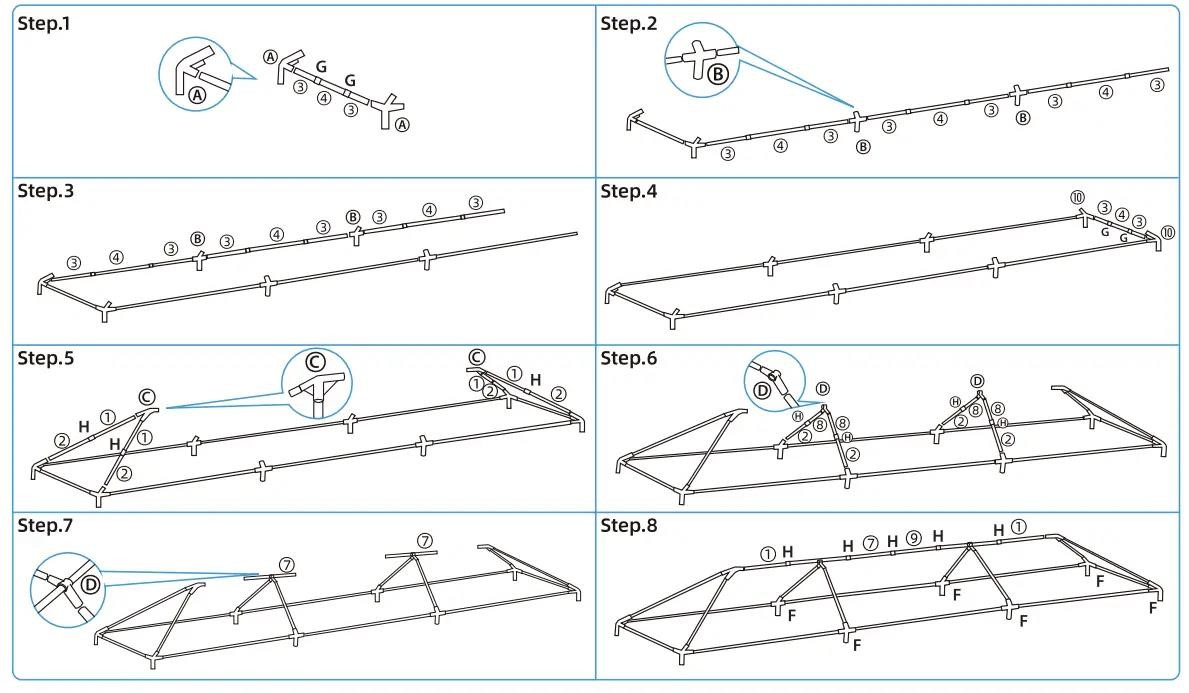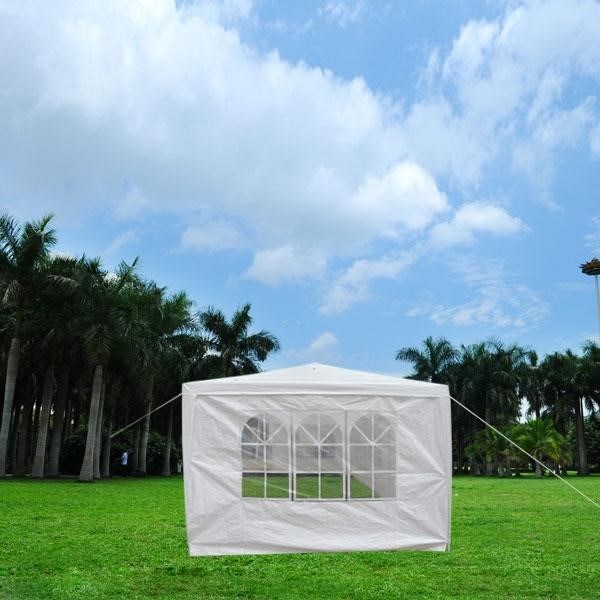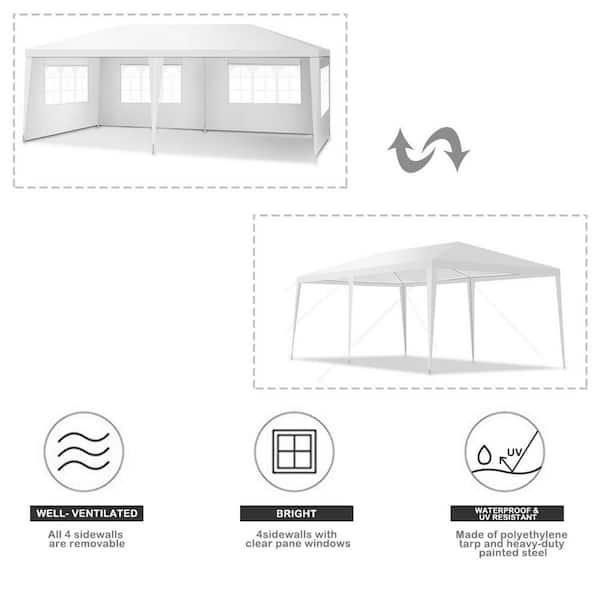10×30 Tent Setup⁚ A Step-by-Step Guide
Setting up a 10×30 tent involves several key steps⁚ pre-assembly preparation (checking parts), laying out the frame components, connecting the poles, attaching the canopy, securing it with stakes or weights, adjusting for stability, and adding optional features like walls or windows. Always consult your specific tent’s instructions.
Pre-Assembly Preparations

Before you begin assembling your 10×30 tent, thorough preparation is crucial for a smooth and efficient setup. Begin by carefully unpacking all components from their packaging. This is a great time to cross-reference the individual parts with the included parts list, ensuring that all necessary pieces are present and accounted for. Any discrepancies should be addressed immediately with the supplier. Choose a suitable location for your tent, ensuring the ground is level and free from debris, rocks, or sharp objects that could damage the tent fabric or frame. Having a helper can significantly speed up this process and reduce the risk of errors.
Next, organize the components. Group similar items together; for example, separate the frame poles, connectors, stakes, and canopy. This methodical approach prevents confusion during assembly and helps maintain a tidy workspace. If your tent includes additional features like sidewalls or windows, set these aside until the main frame is erected. Finally, gather any necessary tools, such as a hammer or mallet for driving stakes into the ground. With all components accounted for and organized, you’re well-prepared to proceed to the next phase of the tent setup.
Laying Out the Frame Components
With pre-assembly preparations complete, the next step involves carefully laying out the frame components. Select a spacious, level area, preferably a clean, flat surface to avoid obstructions and potential damage to the frame parts. Begin by spreading out all the major frame components—the long poles, usually made of aluminum or steel, and the connecting fittings. Refer to your tent’s assembly instructions or diagrams, as these often provide a visual guide for arranging the poles and connectors in their correct positions. Accurate placement is critical for a stable structure.
Ensure that you lay out the frame components according to the manufacturer’s instructions. Some tents have specific orientations for the main poles, while others might have designated locations for corner connectors or support legs; Carefully examine each component and note any markings or labels that indicate the proper placement or orientation. If unsure, consult the instruction manual or contact the manufacturer for clarification. Take your time to double-check each component’s position. A well-organized layout will significantly simplify the following steps, making the frame assembly process more efficient and minimizing the risk of errors. Once all frame components are correctly arranged, you’re ready to begin connecting the poles.
Connecting the Frame Poles
With the frame components laid out, begin connecting the poles. This typically involves inserting poles into pre-drilled holes or sleeves located on the connecting fittings. Most 10×30 tent frames use a system of poles and connectors to create a sturdy rectangular structure. Carefully examine each connector to ensure you understand its function and how the poles should be inserted. Some connectors might require specific orientations or locking mechanisms. Proceed slowly and methodically to avoid forcing any pieces together, which could cause damage or misalignment.
Start by connecting the main support poles, typically the longest poles that form the sides of the rectangular frame. Then, work your way to the shorter support poles, often used for additional stability and support at the corners. Make sure each connection is secure and that the poles are firmly seated in the connectors. If you encounter any resistance, double-check the orientation of the poles and connectors. Don’t force any connections; if a pole doesn’t fit easily, it is likely in the wrong orientation. Some tent frames use pins or locking mechanisms to secure the connections; be sure to engage these mechanisms to ensure stability.
Once all the poles are connected, take a step back to visually inspect the frame. Ensure that all the connections are secure and that the frame is square and stable. Any misalignments or loose connections should be addressed before proceeding to the next step. A properly assembled frame is crucial for the stability and longevity of the entire tent structure.
Attaching the Tent Canopy
With the frame fully assembled and stable, the next step is attaching the tent canopy. This usually involves draping the canopy material over the frame and securing it in place. Begin by carefully spreading out the canopy material on a clean, flat surface to avoid snags or tears. Many 10×30 tents have designated attachment points on the canopy and frame that help ensure proper alignment. These points might be loops, grommets, or other fastening mechanisms. Carefully align the canopy with the frame, ensuring that the edges of the canopy match the corresponding frame members.
Start by attaching the canopy at the corners, working your way towards the center. This ensures proper alignment and prevents the canopy from sagging or becoming unevenly distributed. Use the provided clips, straps, or ropes to secure the canopy to the frame. Ensure that each connection is secure and that the canopy is evenly draped over the frame. Take your time to avoid pulling or stretching the fabric too tightly, as this could damage the material or cause it to tear.
Once the canopy is attached, step back to inspect the overall appearance. Check for any loose sections or areas where the canopy might be sagging. Make any necessary adjustments to ensure that the canopy is evenly distributed and securely attached to the frame. If you encounter any difficulties, consult your tent’s instruction manual for assistance. A properly attached canopy is essential for creating a safe and functional shelter.
Securing the Tent
With the canopy attached, securing the 10×30 tent is crucial for stability and safety, especially in windy conditions. Most tents come with stakes or weights designed for this purpose. Begin by identifying the designated stake or weight points on your tent. These are typically located at the corners and along the sides of the frame. If using stakes, choose a location with firm, level ground. Avoid rocky or hard surfaces that might damage the stakes or prevent them from properly anchoring the tent. Drive the stakes firmly into the ground at a slight angle, ensuring they provide a solid grip.
If your tent uses weights, position them strategically along the perimeter, distributing the weight evenly. Sandbags or water-filled containers work well as weights. Make sure the weights are heavy enough to prevent the tent from being lifted by wind. For added security, especially in high-wind areas, consider using both stakes and weights. This combination provides superior stability and reduces the risk of the tent blowing away.
After securing the tent, take a step back to assess its stability. Gently tug on the sides and corners to ensure that the stakes or weights are holding firmly. If you notice any looseness, adjust the stakes or weights accordingly. Remember that proper securing is vital for the safety and longevity of your tent. Never leave a secured tent unattended in high winds. Always err on the side of caution when securing your tent, especially in inclement weather.
Adjusting for Stability and Tension

Once the 10×30 tent is secured, achieving optimal stability and tension is key for a safe and functional setup. Begin by visually inspecting the entire structure. Look for any sagging areas or unevenness in the canopy. Slight adjustments might be needed to ensure the canopy sits evenly across the frame. If you notice sagging, gently pull on the affected areas to redistribute the tension. This may involve readjusting the stakes or weights to compensate for uneven ground or wind pressure.
Many 10×30 tents feature adjustable straps or ropes that allow for fine-tuning the tension. These straps usually connect the frame to the canopy or the ground. Tighten these straps gradually, ensuring consistent tension across all sides of the tent. Avoid over-tightening, as this could damage the fabric or frame. The goal is to create a taut, but not overly stressed, structure. Pay close attention to the corners, as these areas are prone to sagging if not properly adjusted.
After making adjustments, walk around the entire perimeter of the tent, checking for any remaining imbalances. Gently tug on various points to test the stability. If necessary, repeat the adjustment process until you achieve a balanced and secure structure. Remember, a well-adjusted tent is not only more stable but also more aesthetically pleasing and provides better protection from the elements. Regularly check the tension, especially during windy conditions, to maintain the integrity of your tent setup.
Additional Features (Walls, Windows)
Many 10×30 tents offer optional sidewalls and windows, enhancing versatility and functionality. Installing these features adds another layer of protection from the elements and enhances privacy. Before beginning, carefully review the manufacturer’s instructions specific to your tent model, as attachment methods may vary. Generally, sidewalls attach to the frame using a system of loops, clips, or zippers. Ensure the frame is stable and properly tensioned before attaching any additional components.
Start by aligning the sidewall with the corresponding frame section. Most sidewalls feature a series of loops or grommets designed to connect with the frame’s poles or support structures. Carefully attach each loop or grommet, ensuring a secure connection. Some models may require the use of clips or zippers to secure the walls to the frame. Pay close attention to the alignment to prevent gaps or mismatches. If your tent features windows, install them according to the manufacturer’s instructions. These are often integrated into the sidewalls and may include clear vinyl or mesh panels.
Once the sidewalls are attached, inspect the entire structure for any gaps or loose connections. Ensure all clips, zippers, and loops are securely fastened. Tighten any adjustable straps to maintain proper tension and prevent flapping. With the sidewalls in place, your 10×30 tent offers enhanced weather protection, increased privacy, and a more finished look. Remember to always prioritize safety and follow the manufacturer’s guidelines for proper installation and use of additional features.
Safety Precautions and Maintenance
Prioritizing safety during and after setup is crucial. Before erecting your 10×30 tent, carefully inspect all components for damage or defects. Ensure the ground is level and free from debris that could compromise stability. Never set up a tent during high winds or severe weather; strong gusts can easily damage or even collapse the structure. Always use appropriate stakes or weights to secure the tent to the ground, especially in windy conditions. The number and placement of securing elements will depend on your tent model and the prevailing conditions. Consult the manufacturer’s instructions for guidance on appropriate securing methods. Regularly check the tightness of all connections and fastenings, ensuring a secure structure throughout its use.
Once the event is over, carefully dismantle the tent, allowing it to dry completely before storing it. Properly cleaning and drying the tent canopy and frame will help prevent mildew and extend the tent’s lifespan. Store the tent in a clean, dry place, away from direct sunlight and moisture. Inspect the tent before each use, addressing any minor repairs promptly to prevent further damage. Avoid overloading the tent and adhere to the manufacturer’s weight limits to ensure structural integrity. Be mindful of fire safety; polyethylene fabric is not fireproof. Keep open flames and heat sources away from the tent;
Following these safety guidelines and proper maintenance practices will ensure your 10×30 tent remains in optimal condition, providing years of reliable use. Remember, regular inspection and prompt attention to minor repairs can prevent more significant problems down the line. Always refer to your tent’s specific manufacturer’s instructions for detailed safety and maintenance recommendations.


